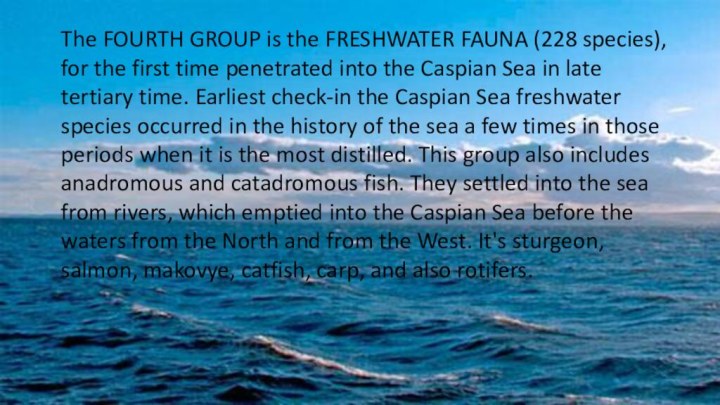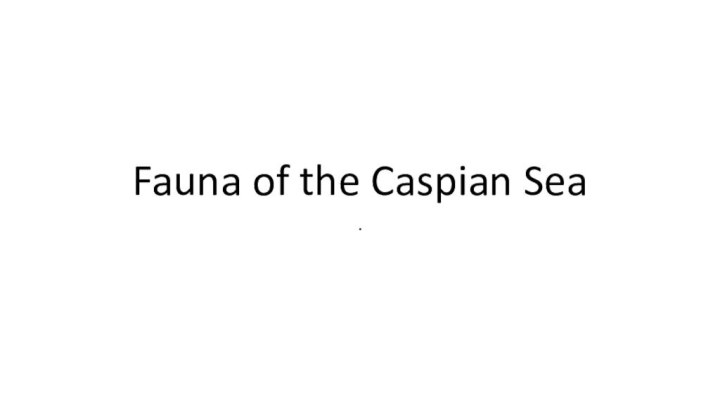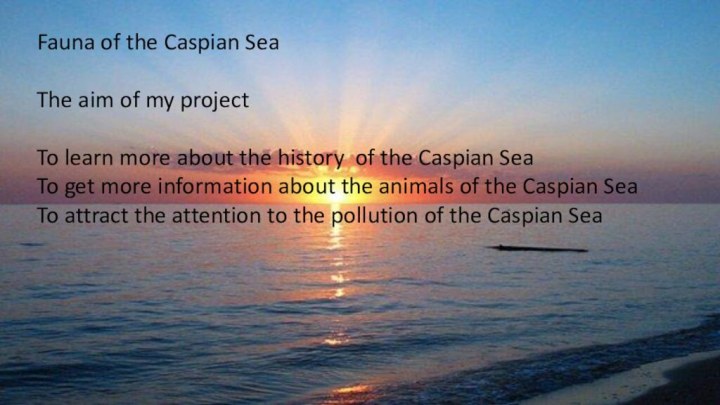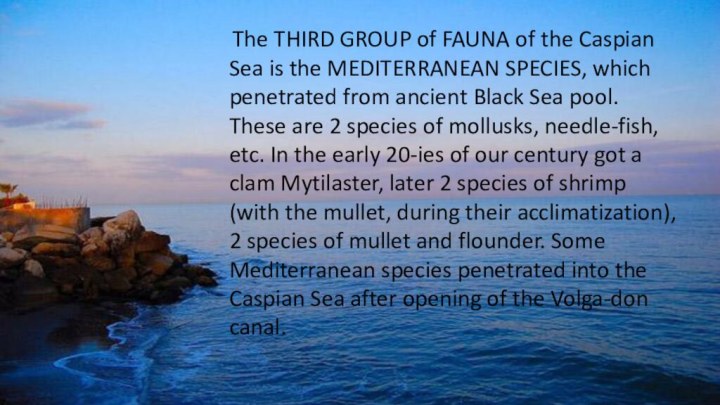Слайд 2
.
Fauna of the Caspian Sea
The aim of my
project
To learn more about the history of the Caspian
Sea
To get more information about the animals of the Caspian Sea
To attract the attention to the pollution of the Caspian Sea
Слайд 3
About 130 million years ago two ancient
supercontinent Laurasia and Gondwana were separated then the mighty
Tethys. Laurasia included part of present-day North America, Asia and Europe, and Gondwana - Africa, South America, Australia and Antarctica. In place of the Tethys, in one of the districts, originated in the Alpine-Himalayan mountain belt.
The ocean water was pushed out of the areas of land elevation, leaving only isolated inland seas in the areas of lowlands and depressions.
Слайд 4
.
Thus the Mediterranean Sea was formed, which then
included the present Sea of Azov, Black and Caspian
Seas. On the site of the modern Caspian Sea a huge Caspian lowland formed, the surface of which was almost 30 meters below the water level in the oceans. When the next rise of land in the area of the Caucasus mountains started, the Caspian Sea was completely cut off from the ocean, and in its place formed closed reservoir which is the largest inland sea on the planet. However, some scientists call it the sea, a giant lake.
Слайд 5
In the Caspian Sea is home to
1809 species and subspecies of animals, of which 1069
free-living invertebrates, parasitic - 325, and spinal animals 415 species.
In the Caspian Sea, it is possible to distinguish 5 groups of free-living animals (1172), which reflect the basic features of its complex history.
Слайд 6
The FIRST GROUP is the CASPIAN AUTOCHTHONOUS
FAUNA. The total number of autochthonous - 513 species
or 43.8% of the total fauna. They are descendants of the ancient forms, which inhabited the Sarmatian and Pontic basins. Their representatives are herring, gobies, and clams.
Слайд 7
The SECOND GENETIC GROUP of the Caspian Sea
constitute the ARCTIC SPECIES, whose ancestors are now widespread
in the Northern seas. They came to the Caspian Sea in post-glacial time, about 10-12 thousand years ago. The total number of Arctic group of 14 species and subspecies, or only 1.2% of the entire fauna of the Caspian sea (sea cockroach, white salmon, Caspian salmon, Caspian seal). The basis of the Arctic fauna are crustaceans (71,4%). She easily carries desalination, indicating that the freshwater of the way the relocation of its North Polar basin into the Caspian Sea over lake-river system that emerged in the post-glacial period.
Слайд 8
The THIRD GROUP of FAUNA of the
Caspian Sea is the MEDITERRANEAN SPECIES, which penetrated from
ancient Black Sea pool. These are 2 species of mollusks, needle-fish, etc. In the early 20-ies of our century got a clam Mytilaster, later 2 species of shrimp (with the mullet, during their acclimatization), 2 species of mullet and flounder. Some Mediterranean species penetrated into the Caspian Sea after opening of the Volga-don canal.
Слайд 9
The FOURTH GROUP is the FRESHWATER FAUNA (228

species), for the first time penetrated into the Caspian
Sea in late tertiary time. Earliest check-in the Caspian Sea freshwater species occurred in the history of the sea a few times in those periods when it is the most distilled. This group also includes anadromous and catadromous fish. They settled into the sea from rivers, which emptied into the Caspian Sea before the waters from the North and from the West. It's sturgeon, salmon, makovye, catfish, carp, and also rotifers.
The FOURTH GROUP is the FRESHWATER FAUNA (228 species), for the first time penetrated into the Caspian Sea in late tertiary time. Earliest check-in the Caspian Sea freshwater species occurred in the history of the sea a few times in those periods when it is the most distilled. This group also includes anadromous and catadromous fish. They settled into the sea from rivers, which emptied into the Caspian Sea before the waters from the North and from the West. It's sturgeon, salmon, makovye, catfish, carp, and also rotifers.
Слайд 10
The FIFTH GROUP consists of MARINE SPECIES.
This ciliate (386 forms), two species of foraminifera. One
of the characteristic features of the fauna of the Caspian Sea is the fact that many animals, once in the new conditions, forming new species. These are amphipods, herring, and gobies. The Formation of new species was the isolation of the Caspian Sea from other seas. In the period of Quaternary, transgressions of the Caspian Sea had a brief communication with other seas; and so on, it entered the Mediterranean and Arctic species.
Слайд 11
The ecological condition of the Caspian Sea
is very complex, is on the brink of disaster.
This ecosystem is changed due to the influence and nature, and man. Before the pond was rich in fish resources, but now, some fish species were under threat of destruction. In addition, there is information on mass disease of marine life, reduction of spawning grounds. In some parts of the shelf formed dead zones.
Слайд 12
The most important Caspian fisheries resource is
the sturgeon, of value both from the point of
view of the fish and its caviar. The Caspian Sea contains up to 80% of the world reserves of sturgeon. There are five species of sturgeon, the biggest fish - Beluga. At the time, this giant fish had a 40% of catching all the sturgeon, now due to the reduction of spawning areas and catching it is 10.
Слайд 13
Another problem is the fluctuation in sea
level, reduction of water, reduction of water surface areas
and offshore areas. Reduced the amount of water that comes from rivers flowing into the sea. The level of these chemical elements (mercury and lead, cadmium and arsenic, Nickel and vanadium, barium, copper and zinc) in the water exceeds all acceptable norms, which greatly harm the sea and its inhabitants.
Слайд 14
. Another problem is the formation of anoxic
zones in the sea, which can lead to catastrophic
consequences. In addition, the penetration of alien species is detrimental to the ecosystem of the Caspian Sea. Previously, there was a kind of testing ground for new species.
Слайд 15
The main polluter of the sea, of
course, is oil. The increased pollution has negative effects
on heat, gas and moisture exchange between the water surface and the atmosphere. Due to the spread in large areas of the oil slick evaporation rate decreases several times. The most prominent influence of oil pollution on aquatic birds. In contact with oil, the feathers lose their water-repellent and insulating properties that quickly causes the birds to death. The mass death of birds was repeatedly recorded in the district of Absheron.
survey among the students of our school, I found
following facts. What kind of animals live in the Caspian Sea? What do you think the Caspian Sea is dirty or clean? What is the Caspian Sea polluted with? 100% of respondents said sturgeon, turtles, snakes, and crayfish. 100% of students believe that the sea is dirty. All of students believe that the sea is polluted with waste and oil.
















